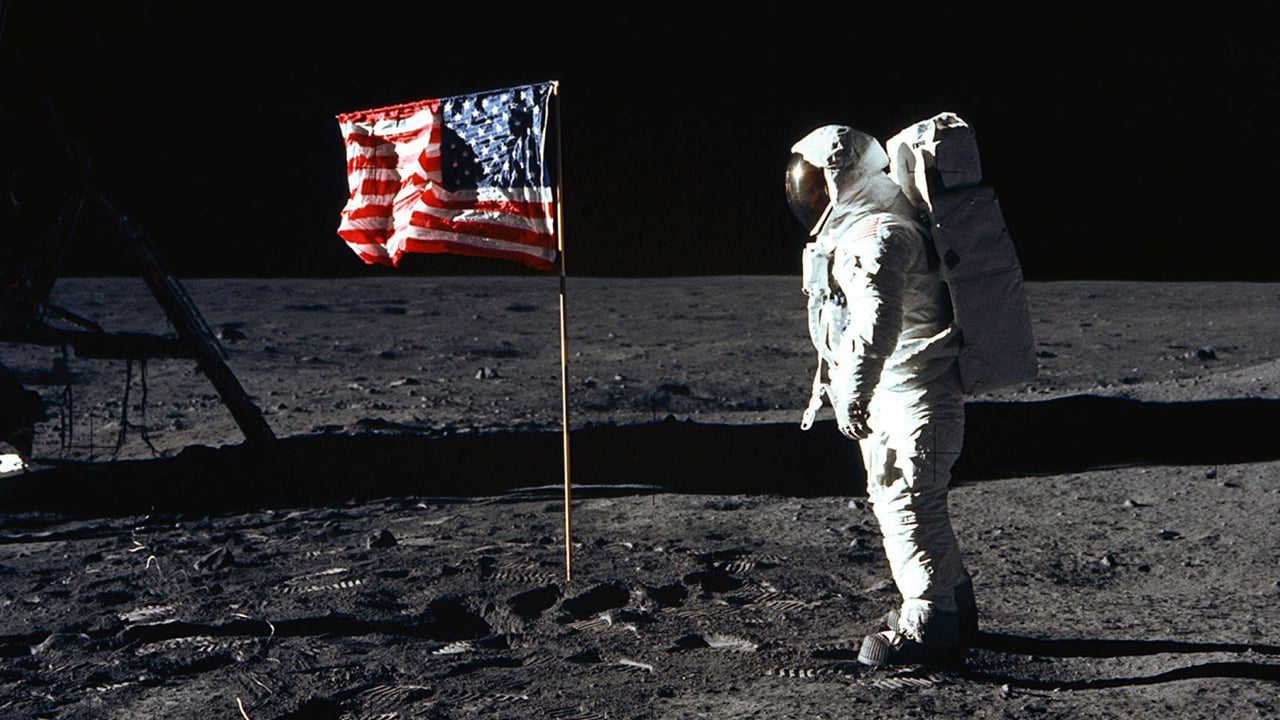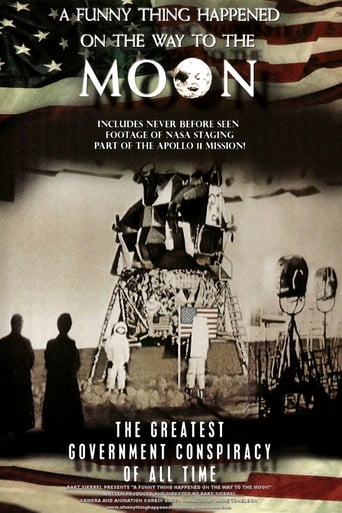

Good concept, poorly executed.
... View MoreThis is a must-see and one of the best documentaries - and films - of this year.
... View MoreExcellent and certainly provocative... If nothing else, the film is a real conversation starter.
... View MoreIt is encouraging that the film ends so strongly.Otherwise, it wouldn't have been a particularly memorable film
... View MoreWatching this moving, I was reminded of Lewis Carroll's Through the Looking-Glass. In chapter 5, Alice says to the White Queen, "One CAN'T believe impossible things." The White Queen replies, "I daresay you haven't had much practice. When I was your age, I always did it for half-an-hour a day. Why, sometimes I've believed as many as six impossible things before breakfast." Because according to Bart Sibrel, the self-appointed Moon landing hoax whistleblower, NASA spent 17 billion 1960s dollars employing thousands of workers and subcontractors and building not just spacecraft and the Johnson and Kennedy Space Centers but an entire and HIGHLY VISIBLE technological infrastructure from scratch, in order NOT to send men to the Moon. According to Sibrel, somehow NASA managed not only to perpetrate on us dolts a vast deception but also to hoodwink an entire small army, from around the world, of scientists, newspaper reporters and magazine journalists AND their editors and publishers and TV and radio reporters AND their crews and producers and networks, many of whom had closely followed the space program every step of the way, up to and including Walter Cronkite and Arthur C. Clarke, neither of whom had shown any previous signs of senility or brain damage.Does Sibrel really believe that we've been the victims of a decades-long conspiracy so shadowy, ubiquitous and impenetrable that it's worthy of the X-Files? Maybe for Sibrel this is a substitute for religion; certainly his obsessiveness about his Moon-hoax delusion has the intensity of religious fanaticism. Does he really believe that TWELVE Americans never really walked on the Moon and that NASA managed to fake not just one, but SIX successful lunar missions? Or does he know the truth and his poor excuse for a film is just a cynical attempt to gain notoriety? Because this film fails either as a serious documentary or as propaganda. It's so laughably inept and full of holes that it would get an F in film school. Is Sibrel not clueless that deliberate misrepresentations, scientific inaccuracies, and logical fallacies don't pass for facts? The film is riddled with non sequiturs. A few miscellaneous items are strung together and suddenly, voilà: A completely unrelated conclusion is presented and a figurative finger is triumphantly pointed at the supposed conspirators as if the conclusion were obvious instead of ridiculous. Several interviews were obtained under false pretenses, and Sibrel is clearly too thick to comprehend that the interviewer isn't asking tough and hard-hitting questions, he's just being obnoxious. Or else Sibrel was deliberately trying to goad them into losing their patience and their tempers. Then Sibrel jumps up and down and points: "See? He got mad. He MUST be hiding something." Sibrel is so self-involved that he thinks this part of the film will lead the viewer to see him as a crusading reporter or courageous whistleblower; instead, "detestable nut-job" tends to spring to mind.But the film's real downfall is simple and obvious: The positive reviewers probably are far too young to have actually witnessed the Mercury, Gemini and Apollo programs. If they had, they'd immediately realize why Sibrel's contention is bunk: Because most Gemini and all Apollo missions broadcast TV shows from space. If you believe that, then you also have to believe that we're able to create true zero gravity here on Earth and that THAT also has been covered up. You can create free fall in the Air Force's "Vomit Comet" for 45 seconds or so at a time, but not for the 20 or 30 minutes that the shows sometimes ran. Or else you have to believe that there was ALSO a cover-up of such advanced visual-effects techniques that a convincing illusion of zero gravity could have been created in a studio. Oh wait, I know: The astronauts stayed in their spacecraft in Earth orbit so they really WERE in zero gravity; they just matted the views out the windows afterward, and of course all of the astronauts had been given acting classes and were bought off. They were ALL to a MAN paid handsomely to PRETEND they went to the Moon. And the scenes from the Moon's surface? Oh right, they were done BEFORE the spacecraft ever took off so they could be cut in at the right time. And NONE of those astronauts EVER spilled the beans, not even to their WIVES or FAMILIES. EVERYONE did a PERFECT job of keeping mum. Everyone. Without exception. Since 1969.While there is still a depressingly large number of Americans who believe in UFOs, alien visitation, and guff like that, a small ray of hope was published in 2011, when a survey reported that the proportion of Americans who believed that the moon landings were a hoax has fallen from 10 percent to 6 percent.
... View MoreI think that a splendid 10 out of 10 rating for this documentary is well deserved, for we owe it to Bart Sibrel to have discovered that Michael Collins was merely a camera man on that infamous trip. What he did was very clever, to darken all the windows of the capsule bar one, and to leave a black veil onto the remaining window with a tiny visible circle. Then as time wore by, he would simply make that circle smaller and smaller thereby creating an optical illusion of and fool us into believing that we were seeing the earth from a distance. Of course, we now know that none of these manned Apollo missions ever travelled into deep space beyond the Van Allen radiation belts. Still though, there are far too many people among us for whom any talk of a lunar hoax sparks off defensive emotions of hysteria coupled with sarcasm and rebuffle. Neil Armstrong has as of today 07/11/2006 spoken merely THREE TIMES about his so called giant leap on the moon! What does that tell you?
... View MoreThe views of Earth that are claimed in this film to have been faked by NASA have recently been compared with the historical weather data for the time of Apollo 11, and show a good match between the cloud patterns in the video sequence and the actual rainfall records on the day.This would seem to undermine the entire argument put forward in the film that the "whole Earth" picture is actually a small part of the planet framed by the spacecraft window.I am waiting for Bart Sibrel to now claim that the historical weather data has been faked by NASA, though that would no doubt involve them in also replacing every archived newspaper copy with a weather map, and the ones in private hands would still be a problem.Ah, a response: "Trying to discredit this movie by referring to NASA weather data I'd say is a charming, but weak and gullible argument. What about the rest of the footage and proofs in the movie? A certain wise man once said something about sifting mosquitoes and swallowing camels. Do you in any way feel that maybe this could apply to what you are trying to do here? :-) This movie is just packed with irrefutable evidence against the claim once made by U.S. government that the moon-missions were a success, and that man now are true masters of the universe. Things are nearly never quite what they seem.. Just watch the movie, and I dear say you'll see things a bit different than before."First off, weather data doesn't come from NASA, it comes for met agencies around the world. Second, the weather data undermines a major claim in the film. Third, far from being "packed with irrefutable evidence", the remaining claims in the film have been thoroughly debunked. Sibrel thought he had a previously secret piece of film, so he edited it and added his own interpretation. Unfortunately for him, his source film is public domain, and the bits Sibrel edited out contradict his claims.
... View MoreI watched "A Funny Thing Happened on the Way to the Moon" after viewing Fox's "Conspiracy Theory: Did We Land on the Moon?" and was impressed with both of them.Really, the two documentaries should be viewed together; there's a lot of overlap of information, but the Sibrel film gets the nod for giving more details about the Van Allen belts, which I believe renders all other points moot.I would have given it a higher rating, but found the music and the narration annoying after a few minutes. Bart Sibrel should have narrated it himself.
... View More